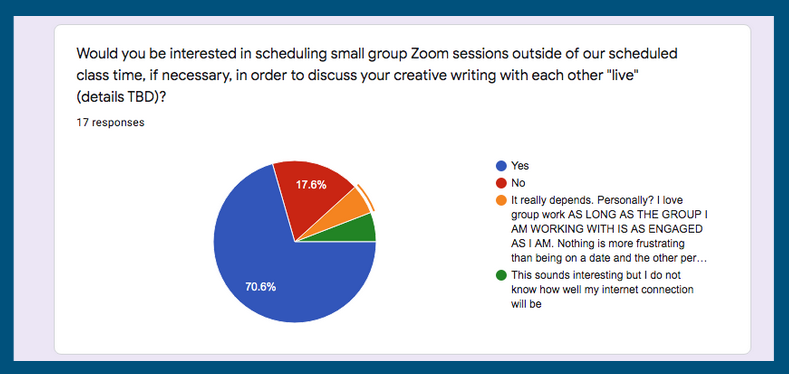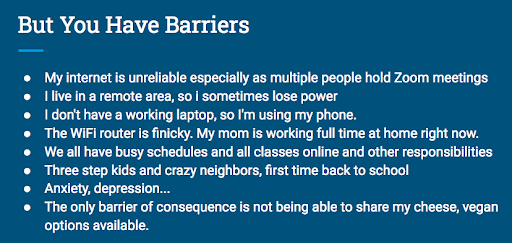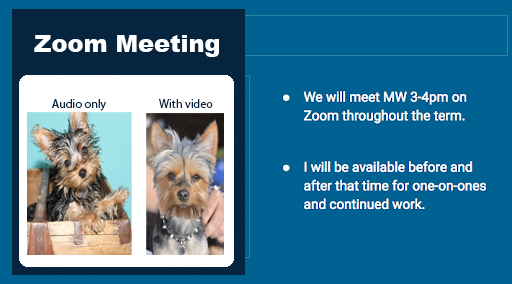This content was published: November 23, 2020. Phone numbers, email addresses, and other information may have changed.
Fostering Community During Crisis
Posted by Greg Kaminski
This week we have Part 2 of a post by Megan Savage, English faculty, co-SAC Chair, and former hybrid faculty mentor. In this post, Megan shares guiding principles for learning during a crisis along with a key strategy for connecting with students at the beginning of a term. It can be used with remote or online classes, and it looks especially useful during the current pandemic. Consider it for the start of winter term! (gk)
Like most of you, I feel the loss of a physical classroom where I can see my students’ expressions, laugh without a lag, and make adjustments on the fly. Fortunately, I have taught online and hybrid courses for years, and so I am used to creating connections in virtual space. The following are strategies I’ve found effective in creating community during the shift to remote teaching, and I hope they will help you too.
Guiding Principles for Learning in a Crisis
I added these Guiding Principles to my Course Overview and syllabi. The principles are adapted from documents shared on the Pandemic Pedagogy Facebook group by Brandon Bayne at UNC – Chapel Hill and by Karen Kendrick from Albertus Magnus College.
1. Nobody signed up for this.
- Not for the sickness, not for the social distancing, not for the economic turmoil, not for the sudden end of our collective lives together on campus
- Not for taking fiction as an online class, not for teaching remotely, not for learning from home, not for mastering new technologies, not for varied access to learning materials
2. The humane option is the best option.
- We are going to prioritize supporting each other as humans
- We are going to prioritize simple solutions that make sense for the most
- We are going to prioritize sharing resources and communicating clearly
3. We cannot just do the same thing online as we would in person.
- Some assignments are no longer possible
- Some expectations are no longer reasonable
- Some objectives are no longer valuable
4. We will foster intellectual nourishment, social connection, and personal accommodation.
- Accessible asynchronous content for diverse access, time zones, and contexts
- Regular synchronous discussion to learn together and combat isolation
5. We will remain flexible and adjust to the situation.
- Nobody knows where this is going and what we’ll need to adapt
- Everybody needs support and understanding in this unprecedented moment
Crisis Check-Ins
The foundation of student-centered teaching is knowing your students. At the beginning of the term, I share a range of “crisis check-in” questions, and invite students to respond to those that speak most to them:
- What has changed in your day-to-day life since COVID-19 (or the wildfires or the widespread racial justice protests) became “a thing”? Which changes have caused the greatest imposition(s)? Which changes have led to the most distress? Which changes, if any, have been pleasantly surprising? Which changes have led to some relief of distress?
- What are things that bring you joy (e.g. activities, hobbies, experiences)? Why do these things increase your joyfulness?
- What are you learning about yourself as a result of recent shifts in your life (related to the issues referenced in #1 in particular)? How have you come to learn these things?
- What is one thing that’s made you feel rooted in the last few days?
- Talk about one person you’re supporting right now. How are you doing that?
- What are you learning about your home, local, and global communities? How have you come to learn these things?
I adapted these questions from ones shared with me in a trauma-focused teaching conversation on the FB Pandemic Pedagogy group with Jill deTemple. Some of these questions speak to crisis, and some that spoke to care and resilience. For more examples, check out the article 5 Questions to Connect During the COVID-19 Quarantine on the website of community-building organization Essential Partners.
You can share these questions in a range of ways: Class-wide Intro Discussions on D2L, as a Google Doc Survey, or in a private email/assignment to you, the instructor. One thing I would encourage you to do is to give students insight into the results if they are not sharing directly with each other, within FERPA guidelines, of course.
For example, last spring, I created a slideshow that I talked through in class, collecting highlights of responses students shared with me in a survey and then illustrating how my teaching choices sprung from those responses:

Chart showing level of student interest in meeting outside of class time

Potential barriers to meeting in Zoom as shared by students

Come to our Zoom meeting! (Video optional)
I hope this strategy is useful for you!
Megan Savage, MFA, MA (she/her/hers)
Instructor, Composition & Literature
Portland Community College, Sylvania
PCC Humanities and Arts (HARTS) Initiative


Thanks for this–I feel l have so much more patience for the frustrations of the students than I do for myself. The Guiding Principles, especially the “We Can’t do the Same Things Online” section was a good reminder to have patience for my own frustrations, too.
Megan, this info is excellent. The Guiding Principles for Learning in a Crisis is just about perfect. I know faculty have been working with students facing all kinds of challenges, but it can be overwhelming to see the cumulative burden on everyone we work with (students, faculty and staff). I think the Check-in is a great way to try and recenter and I hope everyone is keeping this in mind. Thanks for both of your excellent posts!